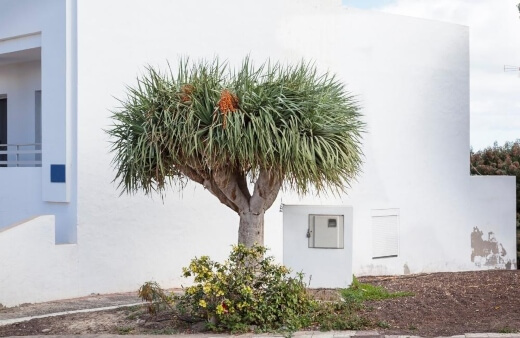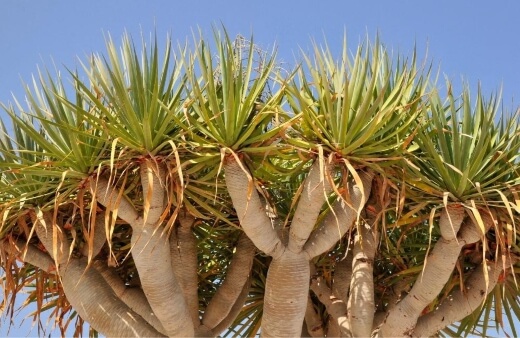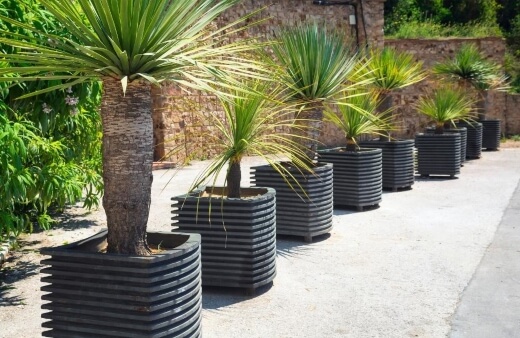Dragon tree, as mythical as its name, is as interesting and unique as a plant can be. Plant lover or otherwise, you will love reading about this magnificent plant. Let’s dive into details.
More...
What is a Dragon Tree Plant?

Dracaena draco, the botanical name for Dragon tree, is a plant, native to the Canary Islands but can also be found in places like western Morocco and Cape Verde. It is thought to have originated from the Azores archipelago.
The plant is more cold-tolerant than other Dracaena species and can even bear temperatures as low as 10°C. This plant usually absorbs most of its moisture from the air rather than the soil, therefore, if you’re planning to plant it indoors, you will find it helpful to install it as an air humidifier.
Outdoors, the plant typically grows to a height of 7.5 to 15 meters with an average length of 4.5 to 7.5 meters. Indoors, however, the plant generally grows very slowly, taking up to 10 years to gain 1.2 meters of height and around 25 years to reach 7.5 meters of height.
It blooms in the spring, but what truly sets it apart are its beautiful white flowers that have a strong, sweet fragrance that can even be smelled from a distance. The plant should be kept away from pets, as it is mildly toxic if consumed.
Interestingly, when the bark of a dragon tree is cut, it secretes a red-coloured resin called dragon’s blood which also has medicinal uses.
How to Grow Dragon Tree in Australia

To grow a dragon tree, you must do the following steps in order.
- Purchase dracaena seeds from a local seed supplier.
- Soak the seeds in room-temperature water to improve the chances of germination.
- Place seed-starting mix inside a pot with a drainage hole at the bottom.
- Lightly hydrate the seed-starting mix.
- Sprinkle the seeds on top of the seed-starting mix.
- Lightly cover the seeds with the seed-starting mix.
- Place the pot over a heat germination mat with 25°C temperature.
- Cover the seeds with a sheet of plastic.
- Place the plant in bright, indirect light. Avoid placing the plant near sunny windows.
- Moisten the seeds to keep the hydration level at the same level throughout the germination.
- If you see water dripping down inside the pot, poke some holes to let moisture out. The seeds may rot if the conditions get too damp.
- After 3-4 weeks, the plants would have germinated. Now you can remove the plastic covering.
- Transfer the plants to individual 7.5cm pots when they grow 2 true leaves.
If you follow these steps, you can easily grow a batch of dragon tree plants.
How to Plant Dracaena draco

The ideal season to plant the Dracaena draco is in the summer season. The reason for this is that dragon trees prefer warmer climates to grow in, and a slightly humid environment is better for their growth.
Both of these conditions can be successfully met in the summer season. Planting the Dracaena draco outdoors is a better alternative, however, planting it indoors also has its benefits.
It grows to a taller stature in the open as compared to indoors, but that also leads to greater maintenance as compared to planting it indoors.
Bright, indirect light is perfect for growing the plant due to direct light being too intense for its growth. Moreover, a lightly moistened environment is ideal for germination.
A seed-starter mix can be used for ideal growth, but mildly acidic soil can be preferred as well.
Dragon Tree Propagation
There are multiple ways through which you can propagate your dragon tree. This includes stem cuttings, leaf cuttings, offsets, plantlets, and so on.


Get Your Free Guide:
Master Growing Australian Natives eBook
A Must Have Complete Guide for Every Australian Garden
Get Your Free Guide:
Master Growing Australian Natives eBook
A Must Have Complete Guide for Every Australian Garden
To propagate a dracaena, cut a stem of 8 inches in length. Be mindful of which end goes down into the soil. The best season to take a cutting and propagate it is in summers or spring.
Place the stem cutting in water or moist soil.
Caring for Dragon Trees
After the seeds have germinated into plants, care is necessary to ensure the plant does not die out in its infancy.
Fertiliser
Fertiliser with a 3:2:1 ratio of nitrogen, potassium, and phosphorus with traces of zinc, iron, and manganese, etc. is ideal for the plant’s growth.
Watering Dracaena draco
One of the most important things to take care of is to make sure that the soil of the plant is porous and well-draining, as too much water near the roots can kill the plant.
It is especially susceptible to salt and fluoride. Therefore, special care must be taken to not introduce any unknown minerals in its soil. If the tips of the plants’ leaves start to turn yellow or brown, it indicates a problem within the plant’s system.
This is usually due to the presence of salt and can be fixed by flushing the soil of the plant and washing it down with distilled water. A 10-14 day frequency of watering the Dracaena draco is typically ideal for its function.

Pruning Dragon Tree
The dracaena grows in the summer and spring seasons and pruning is ideal within these seasons. During dormant winter and autumn seasons, the plant cannot grow as fast, therefore, pruning can be harmful.
When pruning the plant, make sure you use a sharp cutting tool, so you make clean and smooth cuts. Uneven cuts can lead to disease or infection in the plant.
If you don't have one yet, check out our review on the best gardening secateurs available online.
Common Dragon Tree Diseases, Pests, and Problems
Diseases
Dracaena draco is particularly resistant against diseases compared to its other dracaena counterparts. However, it can fall prey to some fungi species, if not taken care of. An example of a fungi infection your plant can suffer from is a fusarium leaf spot.
This will cause yellow or brown spots to appear on budding leaves and will leave a yellow halo on the older leaves.
To fix this infection, you should stop watering overhead so that there is less moisture on the leaves. You can also apply a fungicide, as a last resort, if the infection refuses to leave.
Pests
This plant can suffer an aphid attack. Aphids are small sap-sucking insects that attack in the multitudes and can cause extensive damage to plants.
You can identify if aphids have infected your plant by checking for misshapen, stunted, or yellow leaves on your plant. A sticky substance on the leaves (called the honeydew) is also a sign that aphids have infected your plant.
The honeydew attracts other insects such as ants and ladybugs which cause additional damage to the plant. Moreover, the aphids also cause damage to the fruits and flowers of the Dracaena draco and cause them to become deformed.
Aphids also transfer viruses from one plant to another, often causing fatal circumstances in crops like grain, citrus, etc. It is usually quite easy to get rid of aphids.
If your infestation is a small one, you can hose your dragon tree down with a strong stream of water which dislodges the aphids and gets rid of them. However, if the infestation is of a larger scale, you may need to buy an insecticide.

Common Problems/Tips
The dragon tree is an easy plant to take care of if you know what you are doing. Taking care of some simple things can lead to a quality and problem-free time with your plant.
These are some common mistakes some people make while taking care of their Dragon Plant.
- Watering with tap water is unacceptable since tap water contains salt and fluoride, both of which are harmful to the plant.
- Putting the plant in a sunny environment is also not a wise decision as it may cause the leaves of the plant to turn yellow or brown.
- Not providing the plant with enough fertiliser can cause malnutrition, which may cause deficiencies in the plant.
- Do not overwater this plant. It is particularly sensitive to over-hydration and will die out if proper drainage is not available.
- Ensure that the humidity level of the environment is around 50%. This can be controlled by an air humidifier if the plant is indoors.
Do you want to grow more Dragon trees in your garden? Check out our guide on Dracaena marginata also known as Madagascar Dragon Tree for more info.
Dragon Tree Frequently Asked Questions
How do you take care of a dragon tree?
Dragon trees are fairly drought-tolerant plants that need very little care to stay happy. However, as a guide, they need good light, generous but infrequent water, and an annual feed.
If you stick to that and don’t overwater them they should last for many, many years.
Are dragon trees better indoors or outdoors?
Dragon trees are commonly sold as houseplants but can grow really well outdoors in Australia. Simply find a well-drained spot in the garden with good sun and make sure it’s never sitting in water or over-irrigated.
What is special about dragon trees?
As well as being stunning plants in their own right, dragon trees are revered for their thick red resin, resembling blood, which led to their name, inspired by the legends of Hercules and the 100-headed dragon, thanks to their multiple stems and branches all protruding for their central trunk.
Are dragon trees toxic to pets?
Dragon trees are toxic to pets but rarely fatal. Excessive consumption will cause vomiting, hypersalivation, dilated pupils, aggression and/or weakness, and excessive sleeping.
If you notice your cat or dog has been chewing on your dragon tree, replace it with cat grass or ryegrass as a healthy alternative.
Do dragon trees clean the air?
Dragon trees can help to clean the air in your home and are widely regarded as good air purifying plants. They help to filter out xylene and formaldehyde from the air, and photosynthesise efficiently throughout the day, turning carbon dioxide into oxygen.
What is the best position for a dragon plant?
Dragon plants grow best in bright but indirect light if indoors, to prevent leaf scorch. Outside, they are faster growing and able to stretch their legs in search of more moisture, so can be planted in full sun.
If you grow dragon trees as a houseplant, grow them in bathrooms or humid rooms to help maintain their shiny foliage.
How long do dragon trees last?
Dragon trees are incredibly long lived. With proper care they should outlive you, and everyone you know. Wild dragon trees are reckoned to live for hundreds of years, and can reach over 70 ft tall in nature, making them important markers of the health of the planet, and the climate around them.
Can dragon trees grow in pots outdoors?
Outdoor dragon trees establish and mature faster when planted in the ground, but in small gardens, they can be restricted to 2-3m tall by growing them in pots.
Provide good drainage, and only water them when the soil is dry at the surface.
How often should I water a dragon tree?
Dragon trees need watering once a month indoors, sometimes less in more humid settings. Outdoors, it’s rare that you’ll need to water any dragon tree other than through extreme drought.
Overwatered dragon trees are easy to recognise as their leaves will turn yellow and begin to drop quickly. Stop watering and move your trees somewhere warmer if possible, to help them dry out and recover quickly.
Are dragon trees rare?
In nature, dragon trees are becoming rarer and rarer due to loss of habitat but in cultivation, they are incredibly widespread and are one of the most popular houseplants in most temperature countries.
The challenge of preserving these trees in nature is great, but there are many laws now protecting how and where they can be cultivated or removed.
Do dragon trees have invasive roots?
Dragon trees have gentle roots that cause little to no damage to property. They will not compete with other plants and are a great addition to most sunny borders outside.
One reason some people may consider them to be invasive is that they can send up runners, or volunteers, from their roots, but they are easy to remove or propagate into new plants and won’t cause any damage.
How often do dragon trees flower?
Dragon trees can take about seven years before they flower. That seven years can be counted from propagation, or from replanting into a new location.
Their flowers are temperamental and irregular, but in good sunny, near tropical conditions, they will flower annually.
Wrapping Up Our Dragon Tree Growing and Care Guide
All in all, the dragon tree is a majestic tree that everyone should have on their property. We love it so much we included it on our list of best garden feature trees in Australia. It acts as an air humidifier and has alluring white flowers with a strong, sweet fragrance that can uplift your home environment.
The fact that it is quite easy to grow is an added bonus. Get one of these dragon trees inside your home today.

Published on January 11, 2023 by Gary Clarke
Last Updated on January 31, 2024





I’m wondering if I am able to get your help with my dragon tree. I’ve had this beauty for around 2 years now and recently with being in winter my leaves have turned brown/yellow colour. I’m wondering what this could be if it’s too cold for the tree?
It’s only occurred since being cold in winter. Some of the leaves look to have a mould residue so makes me think cause it’s cold. But I could be wrong.
Just hope I can help it.
Hi Hayley,
I think it might be a combination of things. In a mild winter, with some cold snaps, Dracaena is always going to suffer a bit, but the fact that the leaves look slightly crisp, as well as brown, makes me think it might be a combination of cold damage (to the leaves), accompanied by some winter damage to the roots.
Just because the pot is quite shallow, so any cold is going to penetrate the soil really quickly. Around the base of the crown, it looks like there’s been some defoliation too, where some of the worst leaves have maybe come off? That can indicate either under watering, or damaged roots.
I’d maybe scrape away some of the stones and check the condition of the roots if you can.
I’m probably making it sound worse than it is, but it looks like it should recover. I’ve seen dracaena that look a heck of a lot worse than that, and they’ve grown back, so with a bit of love (and taking care not to overwater it until the weather warms up) it should be ok by summer.
PS. If any of those brown dry leaves start to go yellow, or soft, take them off – just in case it’s fungal. For now, I think it’s more likely to be cold damage, and some root stress.
Best regards,
Gary Clarke
Hi Gary,
Thanks so much for helping me out with this. I’ll take out the rocks and have a look at what it’s like on the roots. I really appreciate your time.
Thank you,
Hayley Chester
Hi,
I’ve noticed what looks like mould on the leaves. The inner stems are healthy and green I’ve dug out a section to check part of the tree roots and they look fine. No soft spot or root rot from what I can see. The soil is dry but not feeling like it’s holiday moisture for rot to occur. I’ll further dig out the golden barrels and see what I find. Maybe it’s in another section.
I’ll add in some new soil with course sand mixed into it and also a fertiliser suitable for this tree. Do you have any recommendations I could use?
Hi Hayley,
Are there any signs of mites? They’re TINY, so really hard to spot. They can cause all sorts of fungal problems, and thrive when the soil is quite dry, which might add up. In which case, any balanced fertiliser will be fine, but treatment might need some sort of organic insecticide or fungicide too by the look of it.
I wouldn’t have suggested it before in case it was something else, but you could definitely try either a neem oil spray or pyrethrum. Both are effective against spider mites and mites and would also prevent them from feeding on the tree, but neem oils would also help to kill off any moulds of fungus that are present on the tree or within the leaves.
The black spots are quite distinct, so do seem to indicate some sort of infestation, and the quantity and spacing of them looks most like mites. Even if it’s something else causing it, the neem should help kill whatever fungus is causing it.
Those leaves won’t recover back to lush green again, but if the treatment works, you’ll get a fresh set of leaves when it recovers.
Best regards
Gary Clarke